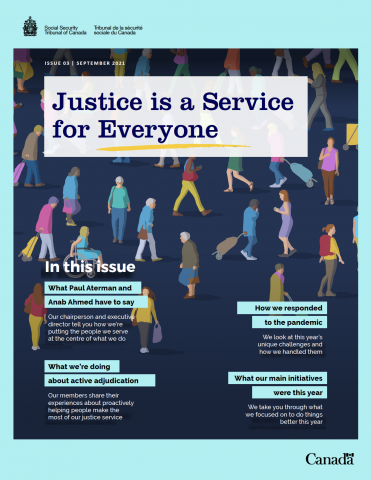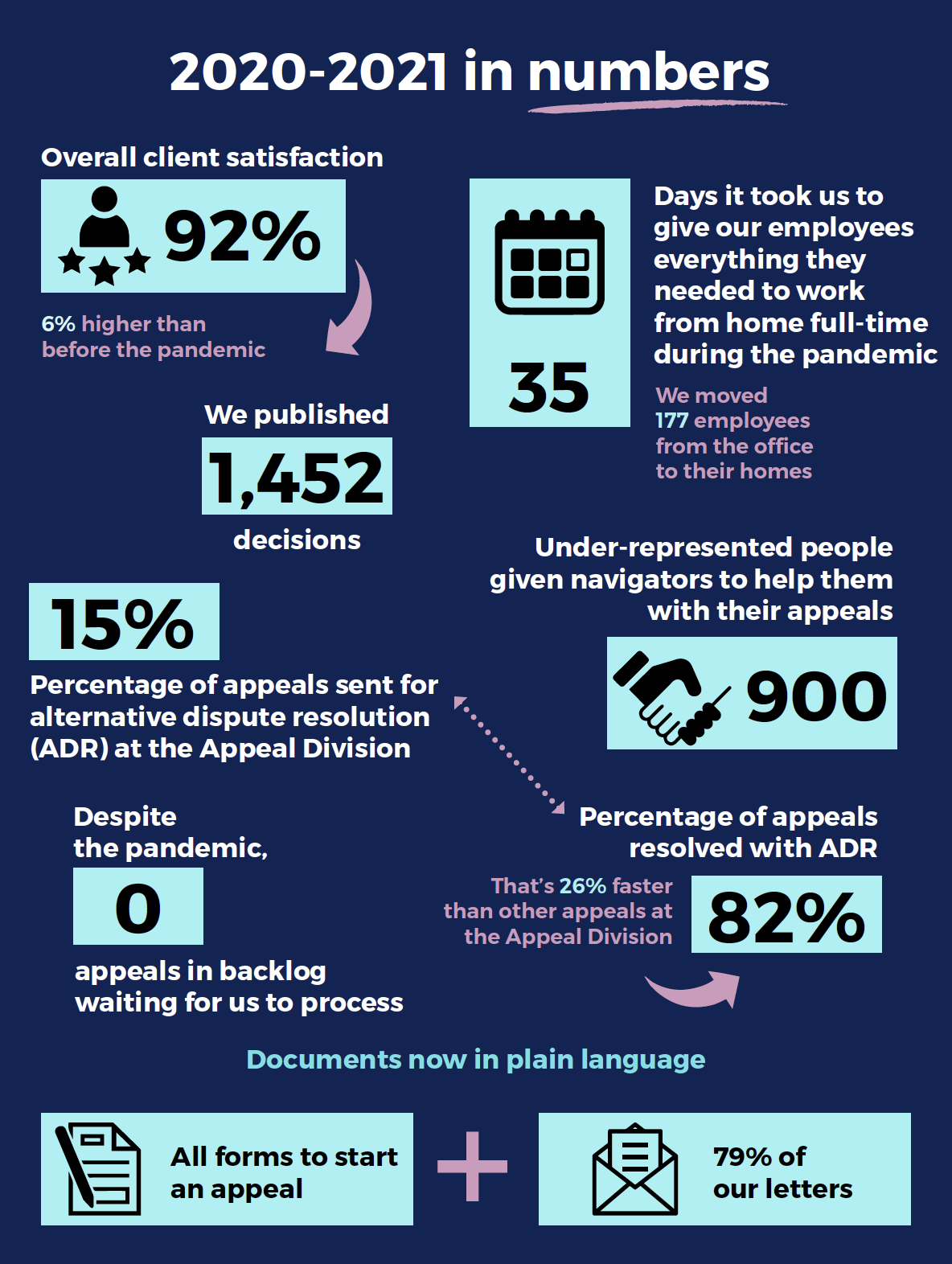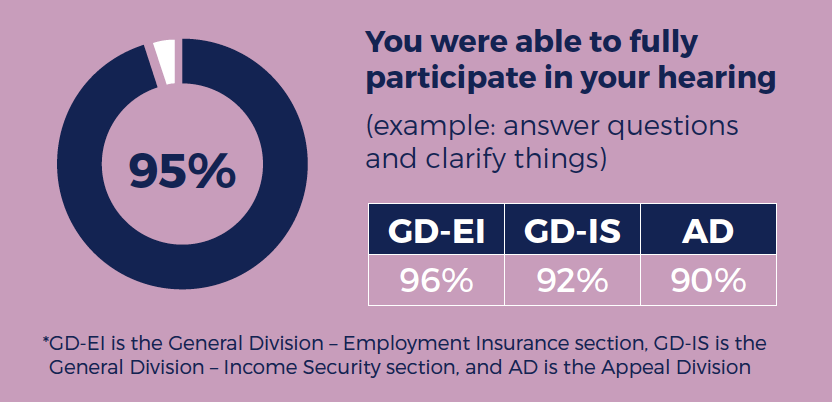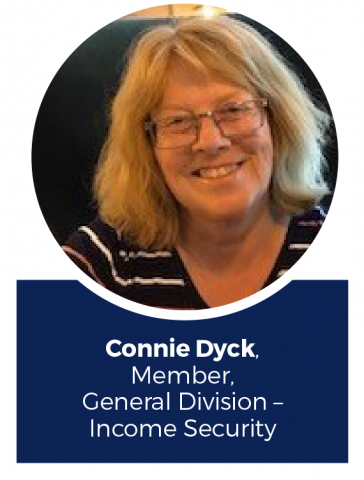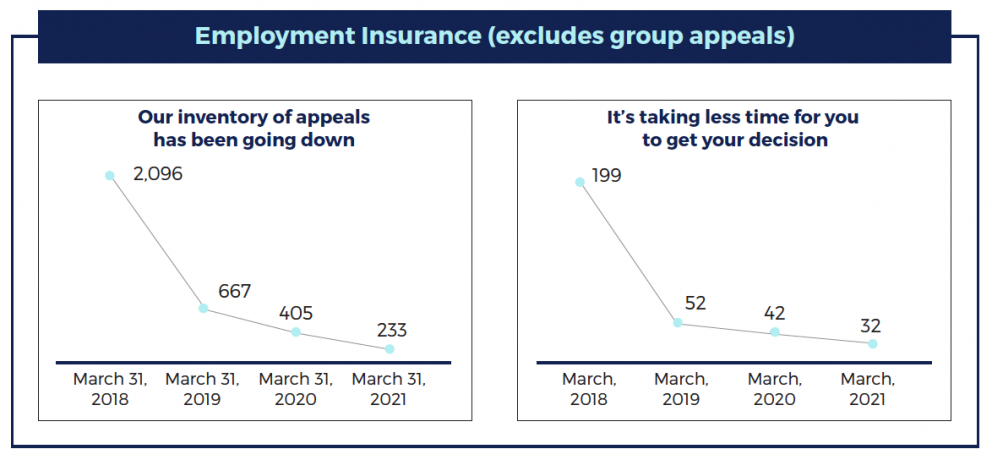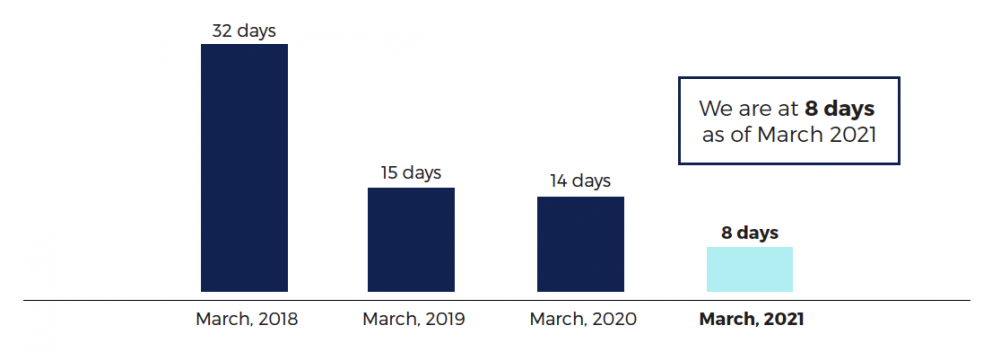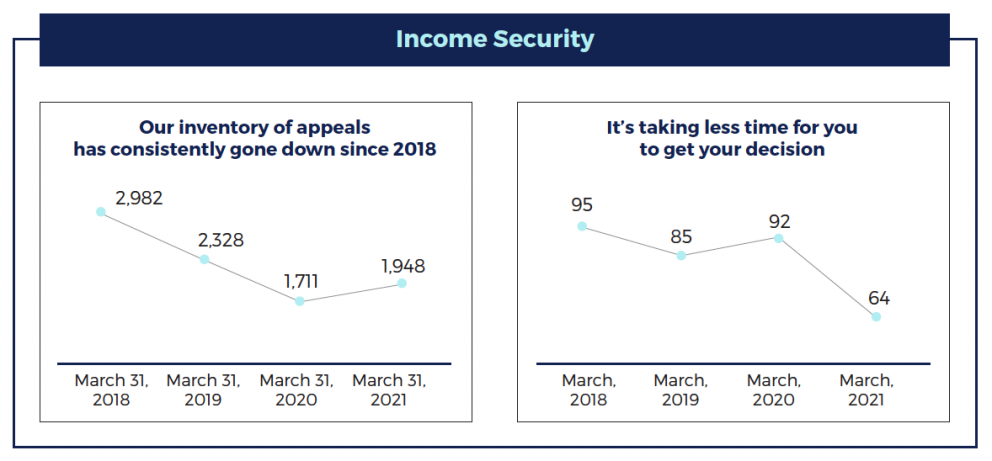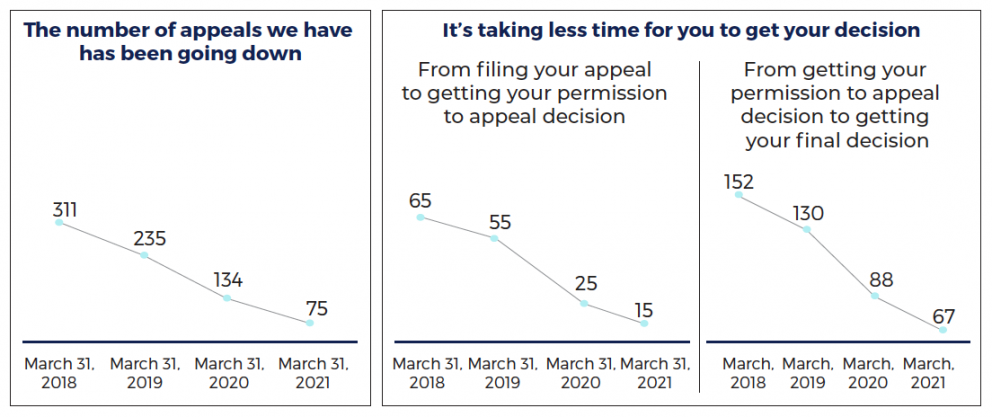2021 Progress Report: Justice is a service for everyone
We wrote and published this report in Ottawa, the traditional unceded territory of the Algonquin Anishnaabeg people.
We understand we’re part of a larger conversation about reconciliation. We began to explore what Indigenous issues, truth, and reconciliation mean in what we do at our tribunal.
This year, we worked with the First Nations University of Canada to take the “4 Seasons of Reconciliation” course.
We know this is only the beginning. We continue to look at how we can participate in reconciliation in a meaningful way as part of a justice system that aims to serve everyone.
People will be reading this report in many places across Canada, which will include other traditional Indigenous lands. We invite you to learn more about the people whose land you’re on.
We can all take part in reconciliation.
The Social Security Tribunal of Canada (SST) decides whether you can get these benefits:
- Employment Insurance
- Canada Pension Plan disability
- Old Age Security
Our federal social support system is built on these benefits. Anyone who qualifies can get them to help meet their basic needs. The SST gives you the opportunity to challenge a government decision about whether you qualify.
March 11, 2021, marked one year since the World Health Organization declared a global pandemic. At the SST, we had to figure out how to offer people the same level of service as before the pandemic started.
In this year’s progress report, we tell you:
- how we responded to the COVID-19 pandemic
- what we’re doing to make it easier for people to access justice
- how many appeals we resolved this year and how long that took
- what we’ll do next year
2020-2021 in numbers
Text version
2020-2021 in numbers:
- Overall client satisfaction: 92%
That’s 6% higher than before the pandemic - Days it took us to give our employees everything they needed to work from home full-time during the pandemic: 35 days
We moved 177 employees from the office to their homes - Published decisions: 1,452
- Number of under-represented people given navigators to help them with their appeals: 900
- Appeals sent for alternative dispute resolution (ADR) at the Appeal Division: 15%
82% of these appeals were resolved with ADR. That’s 26% faster than other appeals at the Appeal Division - Appeals in backlog waiting for us to process: 0
- Forms to start an appeal written in plain language: 100%
- Letters written in plain language: 79%
Responding to the pandemic
We continued to serve you without delay
The pandemic didn’t slow us down. We handled appeals on time. We continued with our services and hearings. One of the ways we did this was by offering more Zoom hearings to adapt to pandemic restrictions. 95% of our appellants said they had a positive experience with Zoom.
At the SST, you can choose what type of hearing you want to have. And you can wait for in-person hearings to start again. At the General Division, we were able to give appellants the type of hearing they said they wanted 95% of the time.
Our client satisfaction survey shows that overall satisfaction is 92%. That’s up from 86% before the pandemic.
How we did it
On March 13, 2020, we learned that we were going to start working from home. This meant moving 177 employees from the office to their homes. By the end of April 2020, we were all set up to work from home.
We continued serving you with as little disruption as possible. We made our digital networks stronger, turned living rooms into mailrooms and call centres, and supported each other any way we could.
Some of the most inspiring stories are about the employees who volunteered to step into other people’s roles to keep things moving.
When we started working from home, not everyone had remote access to our network. For example, our registry officers in the operations team had always worked in the office, so they never needed to connect to the network remotely. But it’s our operations team that does most of the work moving people’s appeals along.
So when we suddenly all had to work from home, employees from different teams came together to help. Some already had remote access and experience working in the operations team. They kept people’s appeals moving along. We had employees from the IT, finance, and human resources teams all helping the operations team until our registry officers had remote access.
I thought that was extraordinary. Their managers didn’t ask them to do it. They did it on their own initiative.
Seeing a need and helping where you can—this is adaptability at its best. Our employees are highly motivated and ready to make sure the SST does what it sets out to do.
— Anab Ahmed, Executive Director
Making the SST more accessible
Removing barriers
We’re removing the barriers you may face at the SST.
Our goal is to help you:
- understand how appeals work so you can appeal with confidence
- participate fully in your appeal
- understand the decisions we make
Here are the results from one of the questions on our client satisfaction survey:
Text version
Percentage of people who were able to fully participate in their hearings per division:
Note: An example of fully participating is being able to answer questions and clarify things.
Employment Insurance – General Division: 96%
Income Security – General Division: 92%
Appeal Division: 90%
Total percentage of people who were able to fully participate in their hearings: 95%
Most common barriers
We use these icons throughout this report to identify the barriers we’re trying to address.
Information
Some people find our forms, letters, and decisions hard to understand.
Service delivery
Some people find our processes complicated and hard to navigate.
Cost
In the last three years, 68% of our appellants represented themselves. Why? Mostly because hiring a professional representative (like a lawyer or consultant) costs too much.
Social and cultural realities
On average, people who use our service read at a Grade 8 level
Over half the people we serve have a high school education or less
7% of hearings this year needed interpreters for languages other than English or French
Many people who appeal to the SST face barriers to justice. In this report, you’ll read about three people: John, Selma, and Mohamed. Their stories are examples of how barriers to justice can have an impact on what you experience. These stories aren’t of actual people, but the personas are based on real people and facts.
John’s story
John is 54 years old and lives in a small town in Alberta. He has a high school education but struggled in school. After high school, he trained and worked as a forklift operator.
He injured his back at work three years ago and hasn’t been able to work since. His back still hurts all the time. His workplace accident benefits have run out, and he can no longer afford treatment.
He doesn’t read or write much in his daily life, and he reads at a Grade 8 level. He struggles to understand the legal language in the SST’s letters and forms. He’s not great with technology. So finding information online isn’t an option for him.
As a homeowner, he doesn’t qualify for legal aid, and he can’t afford a lawyer.
This year’s initiatives
What’s clear and simple is that once you start thinking about the people who use the system, they become the focus for almost everything you do.
— Paul Aterman, Chairperson
SST navigators: Supporting our appellants
A navigator guides you through your appeal with one-on-one support from start to finish. They can’t offer legal advice or speak for you in your appeal. But they don’t wait for you to ask for help. They reach out to you to get you the help you need right away.
The problem
For people like John and many others, the justice system can be hard to understand. Most people have no idea how a tribunal works. This means people often struggle with the appeal process.
Most of the people we serve are under-represented. This means they represent themselves or they get help from a family member or friend. They don’t have professional representatives (like lawyers).
Navigators worked on
900
appeals this year, helping under-represented appellants
93%
of appellants who had navigators said it helped them get ready for their hearings
93%
of appellants were satisfied with their navigators
What we did
We offered our navigator service to more appellants this year. It now covers all appeals involving the Canada Pension Plan.
Our navigator service also now covers:
- all appeals at the Appeal Division
- Employment Insurance appeals at the General Division that involve the Canadian Charter of Rights and Freedoms
This year, we evaluated our navigator service to make sure it’s working the way we want it to. Our evaluation shows that navigators help remove barriers and improve access to justice in two ways:
- Appellants continue with their appeals
- Appellants participate more
Before navigators, 18% of appellants withdrew (cancelled) their appeals. Now that number is just 7%. This shows that appellants are more confident moving forward with their appeals when they have navigators to help them.
95% of appellants said they were able to fully participate in their hearings. For example, they were able to answer questions, correct any errors about the facts, or explain their cases. They said that this was because of their navigators and how flexible SST members (the decision-makers) were.
SST members said that appellants with navigators were more prepared, knowledgeable, and involved.
Our navigator service works very well for most people, but we can still improve it.
For about 7% of appellants, support from navigators doesn’t work. Some people don’t want help. For others, it’s because of the following:
- They aren’t fluent in English or French
- They have a mental health or physical disability
- They don’t trust the government
What comes next
We know the navigator service helps appellants. So we’re expanding it so all appellants at the General Division – Income Security section and all appellants with group appeals at the General Division – Employment Insurance section can use it. As we make changes to the navigator service, we’ll continue asking people how we can make it better.
We also want to hear what experts outside the SST think of the service. So two professors (Dr. Laverne Jacobs from the University of Windsor and Dr. Sule Tomkinson from Université Laval) will do an independent study next year. They’ll look at how navigators serve these marginalized communities:
- people with disabilities
- older people
- racialized people
- people with low income
We’ll share the results of the study on our website.
Visit our navigator service page for more information on this service and our evaluation.
Plain language: Writing so you can understand us
“The legal terms weren’t easy to understand.”
Appellant, General Division – Employment Insurance
“I found some of the documents long, especially the employment documents. Is it possible to narrow them down?”
Appellant, General Division – Employment Insurance
These quotes are from our client satisfaction survey
The problem
Legal language in our forms, letters, and decisions can be confusing and hard to understand.
What we did
We’ve been replacing or explaining complex legal language in our documents with more common language. We’re working hard to make our documents easier to understand.
We use this definition of plain language from the International Plain Language Federation to guide us in how we communicate:
“A communication is in plain language if its wording, structure, and design are so clear that the intended readers can easily find what they need, understand what they find, and use that information.”
Decisions
We’ve trained our members to write their decisions in plain language. Our goal is to write all of our decisions at a Grade 9 reading level.
To see whether we’ve been making progress, we evaluated how easy it is to read and understand our decisions.
The results of our evaluation show that we’re not where we need to be. We’re making slow but clear progress at writing decisions at a Grade 9 reading level.
Read more about the evaluation and our progress in “An evaluation of how easy it is to read decisions of the Social Security Tribunal.”
Text version
Improvement on members’ decision writing after plain language training
Decisions read at a grade 9 level or below:
Before training: 30%
After Training: 42%
What comes next
We know we still have work to do. Right now, only 43% of our decisions explain the law in a way that most people can understand. We’ll keep training our members to write in plain language for as long as it takes to reach our goal.
We also know we can’t avoid using some legal terms in decisions. So we’re creating a glossary that appellants can use when they see a term they don’t understand. Look for it on our website in the near future.
Forms and Letters
We want to write all of our forms and letters at no higher than a Grade 9 reading level.
The feedback we got from our client satisfaction survey told us that our forms and letters were hard to understand. So we created new, simpler forms.
Our new forms:
- are in an easy-to-read large format
- can adjust to any screen size, and you can read them with a screen reader (in HTML)
- explain how to ask for special arrangements
- give more information about the appeal process
- describe each type of hearing so you can make an informed choice about what type of hearing you want
Now, 92% of people surveyed say our forms, letters, and emails are easy to understand.
We rewrote 79% of our letters in plain language.
We’ve worked hard to make our forms and letters easier to understand. But we know we can always make them better. That’s why we’ve asked for an independent evaluation of how easy it is to understand and use our new forms and letters. The National Self-Represented Litigants Project (NSRLP) is looking at them now. We expect to see the evaluation report in summer 2021, and we’ll publish it on our website.
What comes next
- All remaining letters will be in plain language by the end of summer 2021
- We’ll use what the NSRLP finds and recommends in its evaluation to make more changes to our forms and letters
- We’ll continue making changes to our forms and letters to make them easier to understand and use
Selma and Mohamed’s story
Selma lives in Nova Scotia. She works as an office assistant at an accounting firm. She agreed to help her neighbour, Mohamed, with his Old Age Security appeal at the SST’s Appeal Division.
Mohamed has been struggling with the appeal process. He finds it overwhelming. He has no relatives around to help him and has lived alone since his wife passed away two years ago. He isn’t good at checking the mail. This means he’s missed letters from the SST. He qualifies for legal aid. But his local legal aid clinic doesn’t work in this area of law.
The longer the appeal process goes on, the more stressed Mohamed gets. It’s starting to affect his health. The stress has caused heart palpitations, and he’s on new medication that makes him drowsy a lot of the time.
Selma is worried about Mohamed. She wishes there were a way to resolve the appeal quickly without a formal hearing.
Alternative dispute resolution: Resolving appeals early
The problem
The appeal process can be long, especially when you’re waiting to find out whether you can get benefits. The longer the process goes on, the more stressful it becomes. This can affect your mental, physical, and financial health, like in Mohamed’s case.
What we did
Not every appeal needs a hearing. Appeal Division members consider whether an appeal could be resolved without going through the full appeal process. If it can, we try alternative dispute resolution (ADR).
ADR lets appellants, like Mohamed, talk directly to the other party. With the help of an Appeal Division member, the appeal can be resolved without a hearing. As a result, appeals are resolved more quickly, and appellants participate more fully in the process.
Parties see the value of talking directly to one another and an Appeal Division member. They feel more involved in the process, and appeals get resolved more quickly. This means less stress for everyone involved.
ADR is getting good results
Text version
ADR program’s results
Percentage of appeals sent to alternative dispute resolution (ADR) from Appeal Division: 15%
Percentage of cases at ADR that were resolved: 82%
And they took less time. They finished 26% faster than other Appeal Division cases.
If an appeal doesn’t get resolved with ADR, that’s okay. It doesn’t delay the full appeal process. Appeals that didn’t get resolved with ADR were still resolved on time.
At the end of the day, ADR can get appeals resolved faster, which means less stress and fewer costs for everyone involved.
What comes next
Not every appeal is a good one for ADR. But we’re always looking for the right appeals for the ADR process.
Based on our success with ADR at the Appeal Division, we’ve launched an early resolution pilot project for the General Division – Income Security section. The pilot project involves having conferences (informal meetings with the parties) to look at ways to resolve appeals early.
We’ll share the results of the pilot project on our website and use that information to make the appeal process better for appellants.
Spotlight on active adjudication
Most of our appellants represent themselves. That’s why we encourage members to use active adjudication when they hold a hearing.
Active adjudication means that members work closely with all the parties to guide them through the hearing. They explain clearly what happens in a hearing, ask open‑ended questions, and repeat back to parties what they’ve heard.
Here’s what two of our members say about their experiences:
One of the main goals of active adjudication is making sure the appellant is heard. Appellants often say how thankful they are that someone took the time to listen to them.
Often, interactions up to this point have been only through forms, letters, or emails. The hearing is the first time appellants have the chance to tell their story to a real person. They might be angry, stressed, or worried. And they might have a hard time understanding what they have to do.
Explaining things in a way they can understand, asking questions, and listening to what they say—this not only gets me the information I need to make a decision, it makes the process more human.
I had an appellant (survivor’s pension). She was an older lady who was obviously in a tough situation because she’d lost someone close to her.
After discussing what their relationship looked like (was it common law?), I told her what I tell all appellants: “I know we’ve talked about a lot of things today. But this is your appeal, and I want to give you the last word. Is there anything we haven’t talked about that you want me to know before we end the hearing?”
In this case, the lady had to go to a friend’s house to use Zoom for her virtual hearing. The friend wasn’t a witness, but she took the time to send a letter to the SST. In the letter, she said how much it meant to her to see that her friend had the opportunity to be heard.
Our outreach highlights from the year
Text version
Our outreach highlights:
- We rewrote our Code of Conduct for members in plain language so people can see better what members are supposed to do. We also set up a complaints process.
- We launched our social media presence on Twitter and LinkedIn.
- We continued to work with student legal aid clinics at the University of Ottawa and York University to train law students in representing appellants at the SST for free.
- We had our first Employment Insurance Appeals’ Consultative Committee meeting this year!
- We had two Income Security Appeals’ Consultative Committee meetings.
A note on consultative committee meetings:
Organizations outside the SST can give us helpful information. We meet with people from these organizations in our consultative committee meetings. We keep them informed about what we’re doing, and we share ideas about how the SST can offer a better justice service.
This year’s service standards and processing times
Serving you faster – General Division Employment Insurance
A big part of a better justice service is to make decisions quickly. The numbers below are based on information from the last day of March. They’re the most recent numbers for each fiscal (financial) year.
In the Employment Insurance section, the appeal process is faster and there are fewer appeals waiting to be heard.
Text version
Employment Insurance (excludes group appeals)
- March 31, 2018:
- Number of active appeals: 2,096
- Average number of days it took to get a decision after a hearing: 199
- March 31, 2019:
- Number of active appeals: 667
- Average number of days it took to get a decision after a hearing: 52
- March 31, 2020:
- Number of active appeals: 405
- Average number of days it took to get a decision after a hearing: 42
- March 31, 2021:
- Number of active appeals: 233
- Average number of days it took to get a decision after a hearing: 32
The two side by side line graphs show that our inventory of appeals has been going down and that it’s taking less time for you to get your decision.
Our service standards
Our goal this year was to give appellants their decisions within 45 days of when they filed their appeals. We wanted to do this at least 80% of the time.
How we did
We came close to meeting our goal during the first half of the fiscal year. And we did better than our goal during the second half of the fiscal year.
Our goal for next year is to stay below 45 days.
Text version
Service Standards April 1, 2020- March 31, 2021
1st Quarter: 74% of decisions made in 45 days or less after filing
2nd Quarter: 74% of decisions made in 45 days or less after filing
3rd Quarter: 84% of decisions made in 45 days or less after filing
4th Quarter: 89% of decisions made in 45 days or less after filing
How long it takes to get your decision
Our goal
We wanted to give appellants their decisions within 15 days of their hearings. We wanted to do this at least 80% of the time.
We did better than our service standard goals!
Text version
Average days for issuing decisions at the General Division – Employment Insurance:
March 2018: 32 days after hearing
March 2019: 15 days after hearing
March 2020: 14 days after hearing
March 2021: 8 days after hearing
The downward trend shows that over the past 3 years we have met and surpassed our target, of issuing decisions within 15 days of hearings 80% of the time.
Serving you faster – General Division Income Security
Over the past three years, the appeal process is faster and there are far fewer appeals waiting to be heard in the Income Security section.
Text version
Income Security
- March 31, 2018:
- Number of active appeals: 2,982
- Average number of days it took to get a decision after a hearing: 95
- March 31, 2019:
- Number of active appeals: 2,328
- Average number of days it took to get a decision after a hearing: 85
- March 31, 2020:
- Number of active appeals: 1,711
- Average number of days it took to get a decision after a hearing: 92
- March 31, 2021:
- Number of active appeals: 1,948
- Average number of days it took to get a decision after a hearing: 64
The two side by side line graphs show that our inventory of appeals has consistently gone down since 2018 and it’s taking less time for you to get your decision.
Our service standards
Our goal this year was to give appellants their decisions within 70 days of when the parties were ready for a hearing. We wanted to do this at least 80% of the time.
How we did
We didn’t meet our goal of 70 days during the year. But we came close.
Our goal for next year is to get below 70 days and stay there.
Text version
Service Standards April 1, 2020- March 31, 2021
1st Quarter: 60% of decisions made in 70 days or less after filing
2nd Quarter: 67% of decisions made in 70 days or less after filing
3rd Quarter: 65% of decisions made in 70 days or less after filing
4th Quarter: 66% of decisions made in 70 days or less after filing
How long it takes to get your decision
Our goal
We wanted to give appellants their decisions within 30 days of their hearings. We wanted to do this at least 80% of the time.
We did better than our 30-day service standard goal!
Text version
Average days for issuing decisions at the General Division – Income Security:
March 2018: 28 days after hearing
March 2019: 17 days after hearing
March 2020: 26 days after hearing
March 2021: 17 days after hearing
This bar graph shows how we’ve surpassed our target, of issuing decisions within 30 days of their hearing 80% of the time, over a four year period.
Serving you faster – Appeal Division
We continued to serve you faster at the Appeal Division.
Text version
Appeal Division
- March 31, 2018:
- Number of active appeals: 311
- Average number of days it took to get a permission to appeal after filing: 65
- Average number of days it took to get a decision after getting permission to appeal: 152
- March 31, 2019:
- Number of active appeals: 235
- Average number of days it took to get a permission to appeal after filing: 55
- Average number of days it took to get a decision after getting permission to appeal: 130
- March 31, 2020:
- Number of active appeals: 134
- Average number of days it took to get a permission to appeal after filing: 25
- Average number of days it took to get a decision after getting permission to appeal: 88
- March 31, 2021:
- Number of active appeals: 75
- Average number of days it took to get a permission to appeal after filing: 15
- Average number of days it took to get a decision after getting permission to appeal: 67
Three side by side graphs show that the number of appeals we have has been going down and that it’s taking less time for you to get your decision.
Our service standards
Permission to appeal
Our goal
We wanted to give appellants their decisions about permission to appeal within 45 days of when they filed their appeals. We wanted to do this at least 80% of the time.
This was shorter than last fiscal year (2019-2020) when we were aiming for 60 days, but we did it.
How we did
We did better than our goal in every quarter (three-month period):
Text version
Service Standards April 1, 2020- March 31, 2021
1st Quarter: no data available
2nd Quarter: 98% of decisions on permissions to appeal made in 45 days or less after filing
3rd Quarter: 99% of decisions on permissions to appeal made in 45 days or less after filing
4th Quarter: 99% of decisions on permissions to appeal made in 45 days or less after filing
Note: In July 2020, we shortened service standards at the Appeal Division. Because of this, service standard data isn’t available for the first quarter. Data shows that it’s taking less time to get your decision at the Appeal Division
How long it takes us to make a decision
Our goal
We wanted to make a final decision within 150 days of giving permission to appeal. We wanted to do this at least 80% of the time.
This was shorter than last fiscal year (2019-2020) when we were aiming for 210 days, but we did it.
How we did
We did better than our goal in every quarter (three-month period):
Text version
Service Standards April 1, 2020- March 31, 2021
1st Quarter: no data available
2nd Quarter: 93% of final decisions made within 150 days of giving permission to appeal
3rd Quarter: 100% of final decisions made within 150 days of giving permission to appeal
4th Quarter: 94% of final decisions made within 150 days of giving permission to appeal
Note: In July 2020, we shortened service standards at the Appeal Division. Because of this, service standard data isn’t available for the first quarter. Data shows that it’s taking less time to get your decision at the Appeal Division.
We’re getting decisions to appellants faster
Number of days between hearing and decision has gone down.
Text version
Average days for issuing decisions after hearings at the Appeal Division:
March 2018: 45 days after hearing
March 2019: 14 days after hearing
March 2020: 32 days after hearing
March 2021: 10 days after hearing
Why we’re so much faster getting Appeal Division decisions to appellants this year
This year, because of the pandemic, the number of appeals at the Appeal Division was less than half the number of appeals last year.
There were 379 appeal applications in 2020-2021, compared with 809 in 2019-2020. This meant that Appeal Division members were able to hear and decide appeals more quickly.
Looking ahead
1. Paul Aterman
Chairperson of the Social
Security Tribunal of Canada
2. Anab Ahmed
Executive Director of the Secretariat
to the Social Security Tribunal of Canada
The theme of this year’s progress report is Justice is a Service for Everyone. We sat down with our chairperson, Paul Aterman, and our executive director, Anab Ahmed, to talk about our next steps in providing a justice service that works for everyone who uses it.
What are the biggest challenges that people who come to the SST face?
Paul: People often say that courts and tribunals are designed to work only for the people inside them. In other words, judges, adjudicators, and lawyers.
We’re trying to change that and treat justice as a service. This means we want to think about things from the point of view of the people who use our service.
The SST doesn’t exist for us to have jobs. It exists so that people can access a justice service that helps them meet their basic needs. It’s not about us—it’s about the people we serve.
How do we change our old ways of doing things and start focusing more on the people using our service?
Step 1: Ask and listen
Anab: To understand the challenges that our appellants face, we made a survey to ask them. We survey appellants regularly to get their point of view and see where we can make our processes better. Appellants told us, for example, that they don’t understand the forms on our website. So one of the things we did was rewrite our forms in plain language.
Also, appellants told us they don’t always understand how to prepare for their hearings. So we’re making sure our navigators can help them understand the process.
It’s important to remember that we’re working for the people we serve.
Step 2: Look at the data
Paul: The other thing we try to focus on is what the data is telling us. We try to base our decisions and changes on real-world data, like the data you get from surveys and evaluations.
Step 3: Never stop trying to do things better
Anab: At our tribunal, we’re creating a work culture where we never stop trying to do things better. We call that a “culture of continuous improvement.” I know it’s not easy for everyone—this includes me. Trying something and then saying we didn’t succeed—that’s hard. But we won’t make any progress unless we try, unless we redesign things, and unless we make things better based on what the people using our service tell us.
So what do we do? As soon as we get results from surveys, evaluations, and information we’ve gathered, we adapt, redesign, and change our work so we can meet the needs of the people we serve.
Paul: Yes. It’s not important to get things perfect the first time around. It’s about doing things gradually. Seeing whether it works, and changing it if it doesn’t. We hope that takes some pressure off our employees and invites them to be creative. The more we encourage people to be creative, the better our results seem to be.
If you had one important message to give people who come to the SST, what would that be?
Paul: My message to people who come to SST would always be the same: Tell us what you think we should do better. It doesn’t start and stop with one initiative. There’s no end point. There’s no limit to what we can do to make things better. So we’ll keep asking you what we can do to help you.

